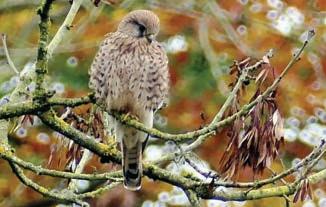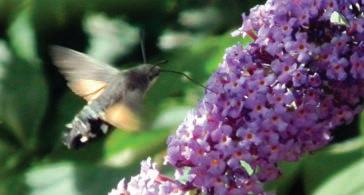
16 minute read
Notes from my Garden David Taft
Notes from my garden
- David Taft
Advertisement
Last year I concentrated on hoverflies, an attractive group of insects which appear in early spring and continue through summer into autumn. The pandemic had forced me to spend more time at home and this had given time for an intense study of smaller garden wildlife. It revealed a much greater diversity of insects than I had imagined, existing here right on my doorstep. This discovery included more than just hoverflies and so I shall also write about some of the other attractive and interesting species. I have previously mentioned that in recent years I have started to see various insects for the first time, which appears to be as a result of climate change, especially the generally milder winters. One such example, which appeared again in 2022, is the fascinating and exotic Humming-bird Hawk-moth (Macroglossum stellatarum). The photograph shows how whilst hovering in flight, it has rolled out its proboscis to suck the nectar from the Buddleja.
The depicted specimen shows the first one that I recorded in the garden, and although I have since seen them every few years, with one this summer; this is the best picture I have managed. The latest UK published moth atlas (up to 2016) shows the distribution of each moth species, indicating that over 1/3rd of all records for this species have occurred since the millennium. It is known that in some winters, along the south coast of England, it can hibernate and survive appearing in warm spells in every month. Normally it arrives from April onwards, as a migrant from the Mediterranean region spreading north and west into central Scotland and even into Ireland. It is worth noting that unlike our other native Hawk-moths this is unusual in being active by day, although it also comes to moth lights at night like the rest of its nocturnal relatives. I would like to try to convince you to take a more interested view of beetles, many of which are handsome creatures when looked at closely, often with bright iridescent colours. Whilst
Humming-bird Hawk-moth (Macroglossum stellatarum) 1st September 2013
many are small like the pollen-beetles, there are enough larger species, so easily seen when they are on flowers eating nectar; especially the large white flower-heads of umbellifers like Cow Parsley, and later in the year Wild Carrot. A group of beetles known as the longhorns is one of the most distinctive and commonest groups, with several species likely to be seen in gardens. The term longhorn refers to the antenna, which are often as long as the body and carried projecting forward from the head in a V-shape. A regular garden visitor and a species that lives up to its name is the Black-and-Yellow Longhorn Beetle (Rutpela maculata). Its larvae develop in deciduous deadwood, and so adults are often found near wooded areas and can be seen from May until September. The 18mm long (3/4 inch) adults are often seen on umbellifers and brambles, and when on umbellifers they seem to become pre-occupied, enabling close inspection. The yellow and black pattern of the wing cases (elytra) is variable and can cause some confusion with other similar species, but the orange bands on the joints of the otherwise black antennae are definitive. The picture shows a specimen enjoying some summer sunshine and basking on a Tutsan leaf, decidedly a handsome and eye-catching beetle.
Another longhorn beetle I have only seen once in the garden was during summer last year. It is a similar sized species to the Black-and-Yellow above but seemed smaller, probably due to its subdued colouring. But, when viewed closely the legs and antennae were bright cobalt blue-grey with black rings on the antennae, which gives a striking appearance. This colouring is unique and cannot be confused with any other species; it is the Golden-bloomed Grey Longhorn (Agapanthia villosoviridescens). It is described as a species of moist meadows and hedgerows, but I found it on my rough grass bank sitting on a leaf in sunshine. It is normally to be found on flowers like
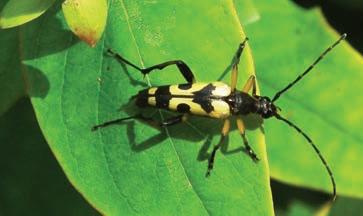
Black-and Yellow Longhorn Beetle (Rutpela maculata) 11th July 2015
umbellifers and in the months of May and June, but may be found a litt le later in the summer. It has an unusual life cycle as it grows as a larvae from an egg laid in the stems of herbaceous plants like thistles and hogweed, where it lives eating the stem contents before retreating to the crown of the plant for winter hibernation. In spring it fi nishes its growth by eating some of the plant roots. Although widespread it is local, but gradually spreading its range from eastern and central England. It seems that so far there are only four records for Herefordshire; but keep an eye open for this remarkable beetle especially on umbellifer fl ower-heads, where so many insects like to spend sunny days. A fi nal longhorn although it has relatively short
Golden-bloomed Grey Longhorn (Agapanthia villosoviridescens) 9th June 2021 antennae in comparison, it is nonetheless part of the family. The Wasp Beetle (Clytus arietis) is aptly named as it looks superfi cially like a wasp and is around 12mm long (1/2 inch). This species is again one that is associated with woodland as the larvae live on fallen and dead wood, and may spend several years eating this not particularly nutritious diet. It is said that adults have been recorded emerging from furniture the process takes so long! The adults are apparently very capable fl yers and can appear on fl owers a long way from their woodland home. They appear in my garden which is surrounded by trees on three sides; but not every year, and when I see them it is usually only one. Wasp Beetle (Clytus arietis) 17th June 2015 They occur commonly throughout Europe although not in the extremities of Scotland or at all in Ireland. Some years they are scarce and sometimes locally common. But, adults are out and about from May to July, and as they come to fl owers to feed you may be lucky to see one almost anywhere. Now for something diff erent! I occasionally see a very distinctive insect in the garden and quite oft en on the surrounding Malvern Hills where its bright appearance would seem to make it impossible to miss. It is a Froghopper within the larger group of insects known as true Bugs (Hemiptera) as they all have a rostrum: mouthparts in the form of a piecing beak-like tube, enabling them to suck sap from plants and occasionally juices from animals. The Red-and Black Froghopper (Cercopsis vulnerata) shown below is one of these fascinating insects. Whilst the shade of red seems to vary somewhat, they are
Red-and Black Froghopper (Cercopis vulnerata). May 2016
so distinctive as to be virtually impossible to confuse with anything else. Truly an insect once seen, never forgotten! They are about 10mm (around 1/3 inch) long but seeming larger with their bright colouring. As their appearance makes them highly visible it is likely to be aposematic (a warning) to would be predators that it is distasteful or poisonous, but I cannot find any reference to this quality. I have usually seen them in spring, but they can be seen from April to August and are found in woodland clearings and open countryside. The nymphs (larvae) apparently feed on roots underground. This insect is found throughout Britain and so far does not seem to be affected by changing climate, and I seem to see it as often now as always. Also with a bright colouring another insect that is the now frequently seen around the Malvern Hills and in my garden is the Scarlet Tiger Moth (Callimorpha dominula). This beautiful day-flying moth has during the last decade or so been increasingly reported in and around the area. Hopefully, many of you will soon see this delightful moth if you have not done so already. Again their bright colours are a warning to birds that they are distasteful. This is a moth that regularly flies during the day as well as at night. My pictures show a mating pair resting on a Box shrub in a secluded corner. The moth appears from late May, through June and into July, and is often seen associated with Green Alkanet, one of its food plants. The Scarlet Tiger was once mainly found only in south and south-west England, but has recently been spreading into the Midlands. The caterpillars feed initially on Green Alkanet or Comfrey and the moth only started to appear locally since the millennium, when Green Alkanet also started to appear. I can remember a time in the early 1990s when Green Alkanet was not seen, and now it is everywhere, with its brightly coloured blue flowers from early spring and through summer, and if trimmed by the highways department I think they start to flower again after some rain even into autumn. Anyway the moth arrived shortly after the Green Alkanet it seems, although Comfrey, its other food-plant, was already here!
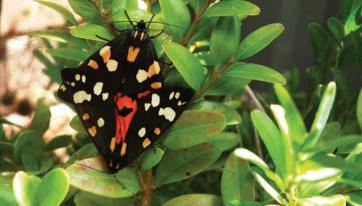
Scarlet Tiger moths (Callimorpha dominula) 11-07-2020
Later in the summer its caterpillars can be found in considerable numbers, as they are hairy and brightly coloured, predominantly yellow and black. They sometimes eat all the leaves of Green Alkanet, leaving just a skeleton. Their hairiness and bright colouring acts as a warning to birds, and they are left alone. The caterpillars hibernate during the winter and finish growing the following spring, before finally pupating and emerging as an adult moth from late May onwards. Strangely when larger the caterpillars will also eat Stinging
Scarlet Tiger moth (Callimorpha dominula) Nettle as was the nearly fully grown caterpillar found on Stinging Nettle 4th April 2018 specimen opposite, which I found in my garden on Stinging Nettle in April. Yet another insect whose range has been changing with the climate is the hoverfly shown below which is about 16mm long (2/3 inch) with a yellow and black abdomen supposedly mimicking a wasp. It is the Wasp Mimic Hoverfly (Volucella inanis). However, it is twice as tubby as any wasp I have ever seen. This species is slightly smaller than the similar Hornet Mimic Hoverfly. The photograph shows a female as the eyes are wide apart and not touching, and she is feeding on native Wild Marjoram growing on my grass bank. These hoverflies were only found in the south-east around the Home Counties, but in the late 1990s they started to expand their range and numbers and started to appear locally 10 years or so ago. However, I still only see occasional specimens, so they can hardly be called common as yet. They will occur on the blossoms of Buddleja and are therefore well worth looking for, as well as their larger Hornet Mimic relation. They are on the wing from July to September and even into October. Late in the year they can be found with a range of insects on the newly opening flowers on Ivy, such a vital source of nectar and pollen at the beginning and end of the year for so many insects.
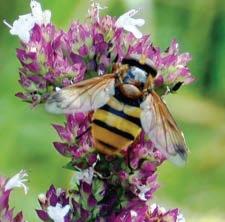
Wasp Mimic Hoverfly (Volucella inanis) 5th August 2022
Now for one of the smallest Hoverflies, called confusingly the Long Hoverfly (Sphaerophoria scripta); it is typically about 5-7mm long (1/4 inch), as can be seen from the specimen feeding on the minute flowers of Black Medick. I suppose it looks long as it has a slender body when compared to many hoverflies. The specimen below is easily identified as a female due to the tapered end to the abdomen, whereas males have a rounded almost bulbous end to their abdomen. The genus Sphaerophoria contains 11 species in the UK and they are considered difficult to separate from each other, especially the males. But, I am confident about this female as it has been confirmed and is the commonest species.
This brightly coloured group of small hoverflies are noticeable for that reason; many small hoverfly species are generally dark and easily overlooked as something more ordinary! The larvae of this species feed amongst ground cover plants on aphids. The hoverfly larvae would be so small that I would think an aphid would be a huge banquet?! This species is visible from spring to autumn and is also thought to be a partial migrant, especially in northern England and Scotland. It is a common species locally, especially in grassy areas, and should be looked for on all sorts of flowers, especially small ones where there is often less competition from other larger insects.
I have decided that if you have read this far and coped with beetles I would mention wasps, especially as I have just discussed a handsome hoverfly that mimics the black and yellow wasp that is to most of us ‘The Wasp’. However, it is worth mentioning that there are several thousand species of wasp in the UK and most of these are overlooked due to their minute size or confusion with flies and bees. There are some eight species that are black and yellow and look sufficiently alike as to be identified as ‘a wasp’ by casual observers. It is worth noting that these are social species, and the Queens and workers form a colony which later in the year will be joined by males. Colonies usually die at the end of the year and are started afresh each spring in a new location by a single queen who has hibernated through the winter. Bees are generally considered to have evolved from wasps, and of course Bumblebees have this same basic social structure. Honey Bees are also similar in this regard but are different in that the colony does not die at the end of every year. Honey Bee colonies may continue almost indefinitely whether domestic in a hive or wild in a hollow tree. Sorry I digress! The typical yellow and black wasps are generally despised by most people for what I guess
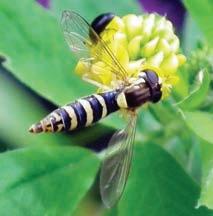
Female Long Hoverfly (Sphaerophoria scripta 16th July 2020, on Black Medick.
are two main reasons. They are not hairy and cuddly like bees, and they have a habit of interrupting late summer picnics, especially when sweet sticky items of food are involved. However, if you put this out of your mind and look at them in spring they are as interesting as any other insects visiting spring flowers. They are then, with a little effort and perhaps a digital camera/phone to record them, able to be identified into their individual species. Spring is a good time as insects are often preoccupied with feeding after their winter slumbers and busy looking for a desirable potential residency for the new season, and so allow a close approach and photographic opportunities. Also, most are queen Bumblebees or Wasps and so there is no confusion with the differences of workers and males that appear later. The picture below is of a queen Saxon Wasp (Dolichovespula saxonica) on 5th April 2020. Saxon Wasp! I hear you say. Yes, this is one of two typical yellow and black species that has arrived since the 1980/90s and is spreading. Having arrived in the south-east it is now scattered across Scotland and Wales. I first saw them in my garden in 2017 and they are now an annual occurrence in spring. I have not seen them during summer, but by then I am looking at too many other things to perhaps notice them. They are distinguished from other species by their abdominal bands with the black shallow triangle and adjacent black dots being reasonably distinctive. A second feature is the lack of a black mark in the yellow face. Facial marks and patterns are often important diagnostic features Saxon Wasp (Dolichovespula saxonica) 5th April 2020 with wasps, and so a photograph of the face and abdomen is always useful. Lastly, something that I am sure you will all appreciate, and enjoy. A female Kestrel (Falco tinnunculus) came and visited the garden and settled in an Ash tree that had dropped its leaves for autumn, although other trees in the background were still hanging on to autumn colour. She lacks the grey head that is a feature of the male Kestrel. After a few minutes I realised she was looking intently at something on the ground, as she twisted and bobbed her head from side to side. Kestrels are birds that haunt and hunt open areas like the Malvern Hills where I invariably see them when walking on the tops. They will often be seen hovering looking for small rodents and shrews. As I live on the west side of the hills, I face the prevailing southwesterly winds, and I therefore often see kestrels facing into the wind assuming a stalled angle in such a way that they are motionless as if hanging from above on an invisible thread. They will twist their wings and tail, and the tail is used as a steering rudder or fan compensating for the changes in wind strength and turbulence. They also have a small feather known as the alula which is effectively their thumb and this can be seen raised and projecting forward from the front of the bend in the wing known as the elbow. It is used to adjust and smooth the flow of air over the top of the wing and stabilise their hovering
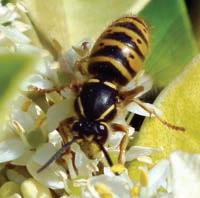
pose. Birds will sometimes remain like this for several minutes without needing to fl ap their wings at all, and their wings, body and tail will be twisting and adjusting while their head and eyes remain stationary and fi xed on the ground below. This is, of course, the source of the other old countryside name of ‘Windhover’ for this delightful small falcon. Of course, it was this habit that inspired Gerard Manley Hopkins to write his fascinating poem ‘The Windhover’. The eyesight of these birds is such that they can see ultra violet frequencies, which are invisible to us; scientists claim this would enable them to see mammal urine in their preferred hunting habitat. You may wonder what advantage this might be, but apparently many small mammals use urine as they move around to mark their territory and this is visible in the ultra violet and so it helps Kestrels to locate them. But as can be seen from this bird, they will sometimes do the lazy thing and watch from a handy nearby tree. Aft er quite a few minutes the Kestrel swooped down quickly onto my patio where it had seen either a Wood Mouse or a Bank Vole. I should explain that my patio slabs are bedded on fi ve points of mortar to level them, and that underneath are a lot of clear spaces which are easily accessible from above via the gaps between the slabs. This provides a lovely place for mice and voles to live and breed, especially as bird seed is conveniently put on some of the slabs over their heads and so becomes mouse and vole food. What happened next was almost comical, as the Kestrel tried putt ing her head down between the gaps in the slabs to see where her potential meal had disappeared. She hopped around the patio repeating this process in several likely places, before giving up aft er a few minutes and fl ying away. Unfortunately, I failed to get an in-focus picture of this strange behaviour.
As I am surrounded by woodland, seeing a Kestrel close-up is a rare treat as they are birds of open spaces. Having just re-read ‘The Windhover’ poem I am now feeling poetic and artistic, and think the picture below should be entitled ‘Symphony in Brown’.
Female Kestrel (Falco tinnunculus) 30th October 2020
